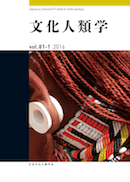Volume 86, Issue 1
Displaying 1-26 of 26 articles from this issue
- |<
- <
- 1
- >
- >|
front matter
-
2021Volume 86Issue 1 Pages f1-
Published: 2021
Released on J-STAGE: September 23, 2021
Download PDF (15673K) -
2021Volume 86Issue 1 Pages f2-
Published: 2021
Released on J-STAGE: September 23, 2021
Download PDF (1719K) -
2021Volume 86Issue 1 Pages 001-002
Published: 2021
Released on J-STAGE: September 23, 2021
Download PDF (3782K) -
2021Volume 86Issue 1 Pages 003-
Published: 2021
Released on J-STAGE: September 23, 2021
Download PDF (131K) -
2021Volume 86Issue 1 Pages 004-
Published: 2021
Released on J-STAGE: September 23, 2021
Download PDF (107K)
Original Articles
-
Article type: Original Articles
2021Volume 86Issue 1 Pages 005-024
Published: June 30, 2021
Released on J-STAGE: September 23, 2021
Download PDF (641K) -
Article type: Original Articles
2021Volume 86Issue 1 Pages 025-043
Published: June 30, 2021
Released on J-STAGE: September 23, 2021
Download PDF (1175K)
Special Theme: A View of Multispecies Ethnography: The World as Seen through the Entanglement of Many Species
-
Article type: Special Theme
2021Volume 86Issue 1 Pages 044-056
Published: June 30, 2021
Released on J-STAGE: September 23, 2021
Download PDF (493K) -
Article type: Special Theme
2021Volume 86Issue 1 Pages 057-075
Published: June 30, 2021
Released on J-STAGE: September 23, 2021
Download PDF (508K) -
Article type: Special Theme
2021Volume 86Issue 1 Pages 076-095
Published: June 30, 2021
Released on J-STAGE: September 23, 2021
Download PDF (616K) -
Article type: Special Theme
2021Volume 86Issue 1 Pages 096-114
Published: June 30, 2021
Released on J-STAGE: September 23, 2021
Download PDF (3781K)
Overview Articles
-
Article type: Overview Articles
2021Volume 86Issue 1 Pages 115-126
Published: June 30, 2021
Released on J-STAGE: September 23, 2021
Download PDF (443K) -
Article type: Overview Articles
2021Volume 86Issue 1 Pages 127-138
Published: June 30, 2021
Released on J-STAGE: September 23, 2021
Download PDF (471K)
Reviews
-
Article type: Reviews
2021Volume 86Issue 1 Pages 139-142
Published: June 30, 2021
Released on J-STAGE: September 23, 2021
Download PDF (545K) -
Article type: Reviews
2021Volume 86Issue 1 Pages 142-145
Published: June 30, 2021
Released on J-STAGE: September 23, 2021
Download PDF (546K) -
Article type: Reviews
2021Volume 86Issue 1 Pages 145-148
Published: June 30, 2021
Released on J-STAGE: September 23, 2021
Download PDF (545K) -
Article type: Reviews
2021Volume 86Issue 1 Pages 148-150
Published: June 30, 2021
Released on J-STAGE: September 23, 2021
Download PDF (537K) -
Article type: Reviews
2021Volume 86Issue 1 Pages 150-152
Published: June 30, 2021
Released on J-STAGE: September 23, 2021
Download PDF (537K) -
Article type: Reviews
2021Volume 86Issue 1 Pages 152-155
Published: June 30, 2021
Released on J-STAGE: September 23, 2021
Download PDF (543K) -
Article type: Reviews
2021Volume 86Issue 1 Pages 155-158
Published: June 30, 2021
Released on J-STAGE: September 23, 2021
Download PDF (544K) -
Article type: Reviews
2021Volume 86Issue 1 Pages 158-161
Published: June 30, 2021
Released on J-STAGE: September 23, 2021
Download PDF (545K)
Information
-
2021Volume 86Issue 1 Pages 162-168
Published: 2021
Released on J-STAGE: September 23, 2021
Download PDF (310K) -
2021Volume 86Issue 1 Pages 169-170
Published: 2021
Released on J-STAGE: September 23, 2021
Download PDF (203K) -
2021Volume 86Issue 1 Pages 171-172
Published: 2021
Released on J-STAGE: September 23, 2021
Download PDF (188K)
back matter
-
2021Volume 86Issue 1 Pages b1-
Published: 2021
Released on J-STAGE: September 23, 2021
Download PDF (1719K) -
2021Volume 86Issue 1 Pages b2-
Published: 2021
Released on J-STAGE: September 23, 2021
Download PDF (320K)
- |<
- <
- 1
- >
- >|
